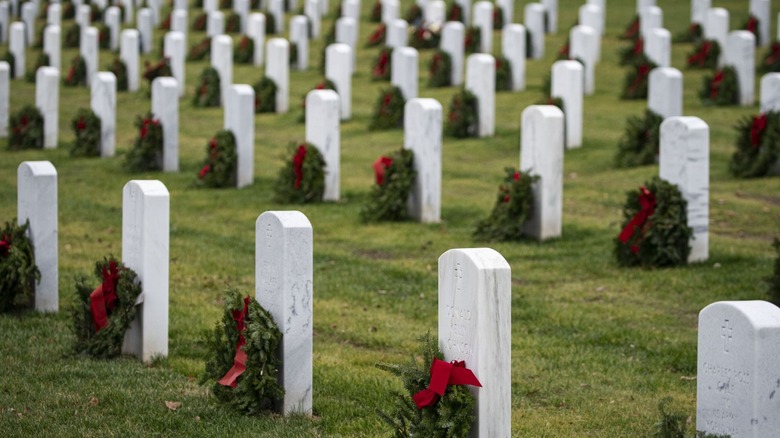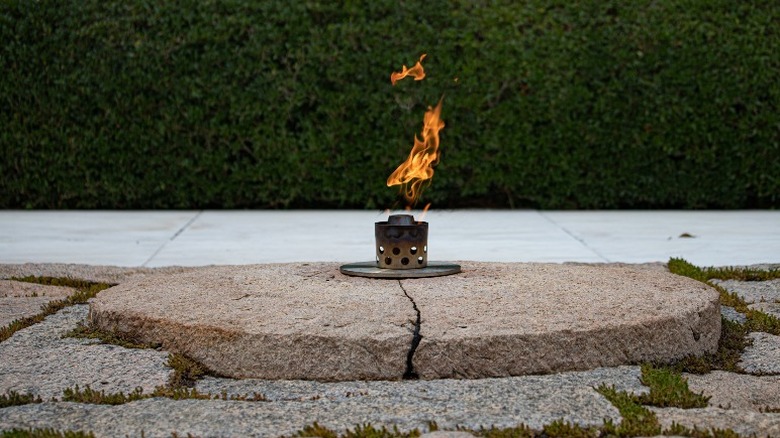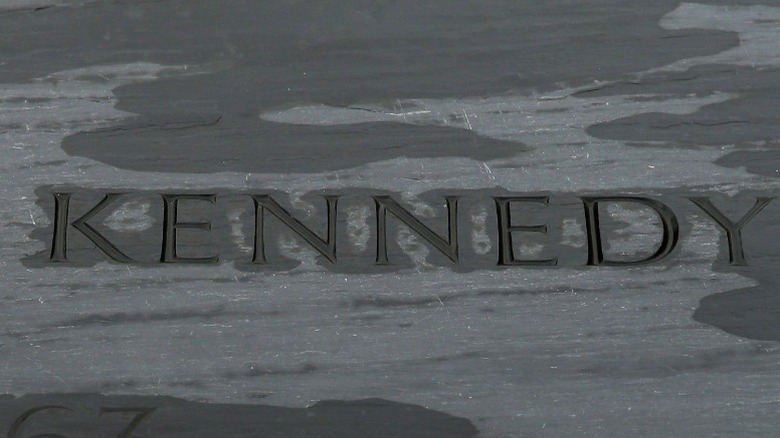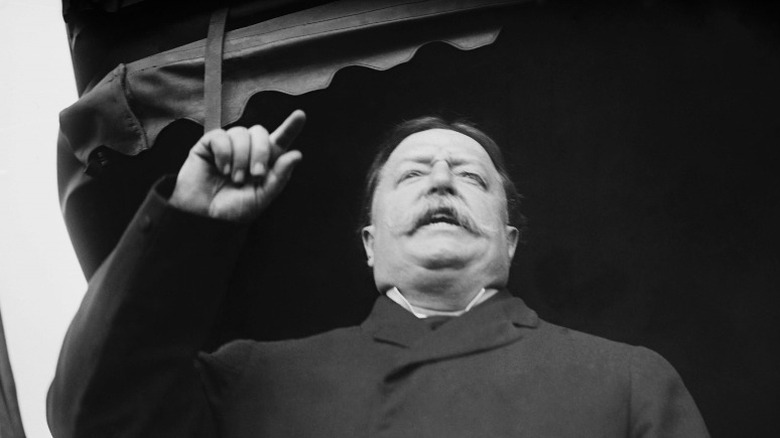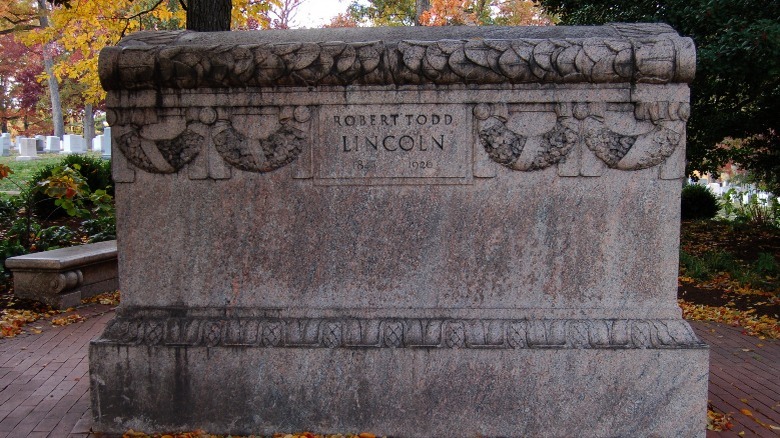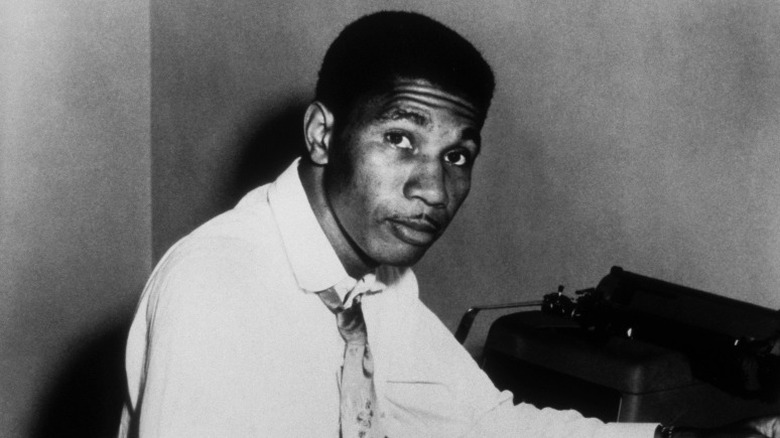The Only Two Presidents Buried At Arlington National Cemetery
The history of Arlington National Cemetery begins with the step-grandson of U.S. President George Washington. The property now encompassed by the cemetery was at first designated as a living memorial to Washington by George Washington Parke Custis, who had the Greek-revival style mansion Arlington House erected on the property in the early 19th century (per Arlington National Cemetery). It was the first monument to the former president.
In the years that followed, the property was inherited by Custis' daughter Mary and her husband, future Confederate General Robert E. Lee, in 1857. After the Civil War began in 1861, the Lees left Arlington House, never to return. The Union army erected four separate forts on the property during the war, as it gave them a strategic high-ground location across from the U.S. Capitol. As Mary Lee hadn't paid taxes after she fled, the U.S. government was able to legally seize it.
The first military burial on the property was in May 1864, when Private William Christman was interred. In June of that year, the Union army officially designated 200 acres of the property as a military cemetery.
While primarily a cemetery for active members of the U.S. military who die while in service to their country, the rules of eligibility for burial at Arlington do extend beyond those who currently serve. The widows and widowers of eligible service persons can be interred here, as are certain members of the federal government. This applies to past U.S. presidents, two of whom have been buried in this national cemetery.
The burial of John F. Kennedy
After the assassination of U.S. President John F. Kennedy, his body lay in state in the East Room of the White House for 24 hours before being moved for public viewing at the Capitol rotunda. Following a funeral at St. Matthew's Cathedral, it was expected that he would be interred at the family plot in Brookline, Massachusetts (per UPI).
In the days that followed JFK's death, a friend of the slain president recalled an experience he once had with him during a visit to the Arlington National Cemetery the previous spring. While walking the grounds, JFK was reported to say that the cemetery was "so magnificent I could stay forever" (per History). This friend relayed these words to JFK's brother-in-law Sargent Shriver, who then reported them to JFK's widow, Jacqueline Kennedy. She was so moved by those words that she decided to have her husband buried at the national cemetery.
She also asked cemetery workers to erect an eternal flame, which they obliged. The torch that lays in front of the president's resting place is fed propane through the ground via a buried copper tube that is connected to a propane tank. Mrs. Kennedy lit the flame during the military funeral service on November 25, 1963. A white picket fence was erected a month later, in part to keep the throngs of mourners away from the flame. What many might not recall is that the flame made it necessary to eventually move the president's grave.
The movement and reburial of JFK
The traffic to JFK's final resting place became a concern to the Kennedy family. History tells us that Arlington Cemetery officials talked with the family about the number of people visiting the grave of the president and how the eternal flame might be compromised at some point. The decision was made to move the flame and grave several feet from the original site so that a more stable base could be constructed for the flame. It would also serve as a better spot for the unexpected amount of foot traffic that arrived at the cemetery, created by admirers who wished to pay their respects to JFK.
Kennedy was moved and reinterred in 1967 in a private ceremony attended by family and by President Lyndon Johnson. The bodies of JFK and Mrs. Kennedy's two infant children were moved from a Massachusetts family plot to be buried next to their father.
The new grave was built with a more stable eternal flame, fed by a permanent natural gas line instead of a copper tube. The flame has a constant electrical spark, in case it gets extinguished by the weather. Completing it are the Cape Cod granite flagstones that surround it.
In the years that followed, both of JFK's brothers, Ted and Robert, were buried in the cemetery near him. Though his widow had remarried later in life, she chose her final resting place to be next to the president.
Taft was the first President to be buried at Arlington
But JFK was not the first U.S. president to be buried at Arlington National Cemetery. Following his death in 1930, former president William Howard Taft was buried in a large plot in a then undeveloped part of the cemetery. After laying in state for three days at the Capitol rotunda, Taft's body was moved for a funeral service nearby (per Arlington National Cemetery). His request for a brief and simple service was granted by his widow, who respected the dead president's wishes. There was a reading of poetry from Wordsworth and Tennyson, but no eulogy.
The graveside service was also very simple, though the funeral procession from the Capitol building was formal. His body's escort to the grave was handled by the 3rd Infantry Regiment.
Taft was the 27th president of the U.S., elected in 1908 with the support of outgoing president Theodore Roosevelt (per Britannica). When his bid for re-election in 1912 failed and Democrat Woodrow Wilson succeeded him, Taft's career in higher government office was far from over. He served on the National War Labor Board during World War I. Then, in 1921, President Warren G. Harding appointed Taft to the U.S. Supreme Court. Taft served on the high court as Chief Justice for nine years, until he retired a month before his death in 1930.
Taft's grave has a link to President Abraham Lincoln
What many might not realize is that there is a connection between President Taft and President Lincoln that can be found at the Arlington National Cemetery. When Taft died in 1930, his widow, Helen Taft, hired sculptor James Earle Fraser (via Arlington National Cemetery) to design the headstone. This piece was crafted from dark mahogany granite from Stony Creek, Connecticut. It stands 14 feet tall and is reminiscent of Classical Greek design work. There are two granite benches on either side of the monument, as well as a brick plaza and lined walkway leading up to it.
Fraser was also commissioned to design and build a grave for Lincoln's son Robert Todd Lincoln. After Robert Lincoln died in 1926, his widow, Mary, hired Fraser to build a monument to her late husband and former Secretary of War. She was buried beside him after her death (per Biography).
Sculpting grave monuments wasn't what Fraser was best known for. On visits to the nation's capital, you can see his handiwork scattered throughout the National Mall at various federal buildings, including the Supreme Court, the National Archives, and the U.S. Treasury building.
Other notable persons interred at Arlington National Cemetery
The Arlington National Cemetery is the final resting place of many famous names that might surprise you. Aside from the two former U.S. Presidents, there are numerous political figures interred there, including the late Ruth Bader Ginsburg, Thurgood Marshall, and former Joint Chiefs of Staff George Marshall (per Tours by Foot). In addition, you might recognize some Hollywood names when walking through Arlington. War-hero-turned-actor Audie Murphy was buried there in 1971, as was decorated war hero Lee Marvin who, like Murphy, became a Hollywood star later in life. World War II veteran and Civil Rights leader Medgar Evers (above) is also resting at Arlington National Cemetery.
Other familiar names include actress Maureen O'Hara (buried next to her third husband, Brigadier General Charles F. Blair Jr.), astronaut and senator John Glenn, veteran and actor Charles Durning, and veteran and big band leader Glenn Miller. The cremated remains of the crew of the NASA space shuttle Challenger are also enshrined at the cemetery.
